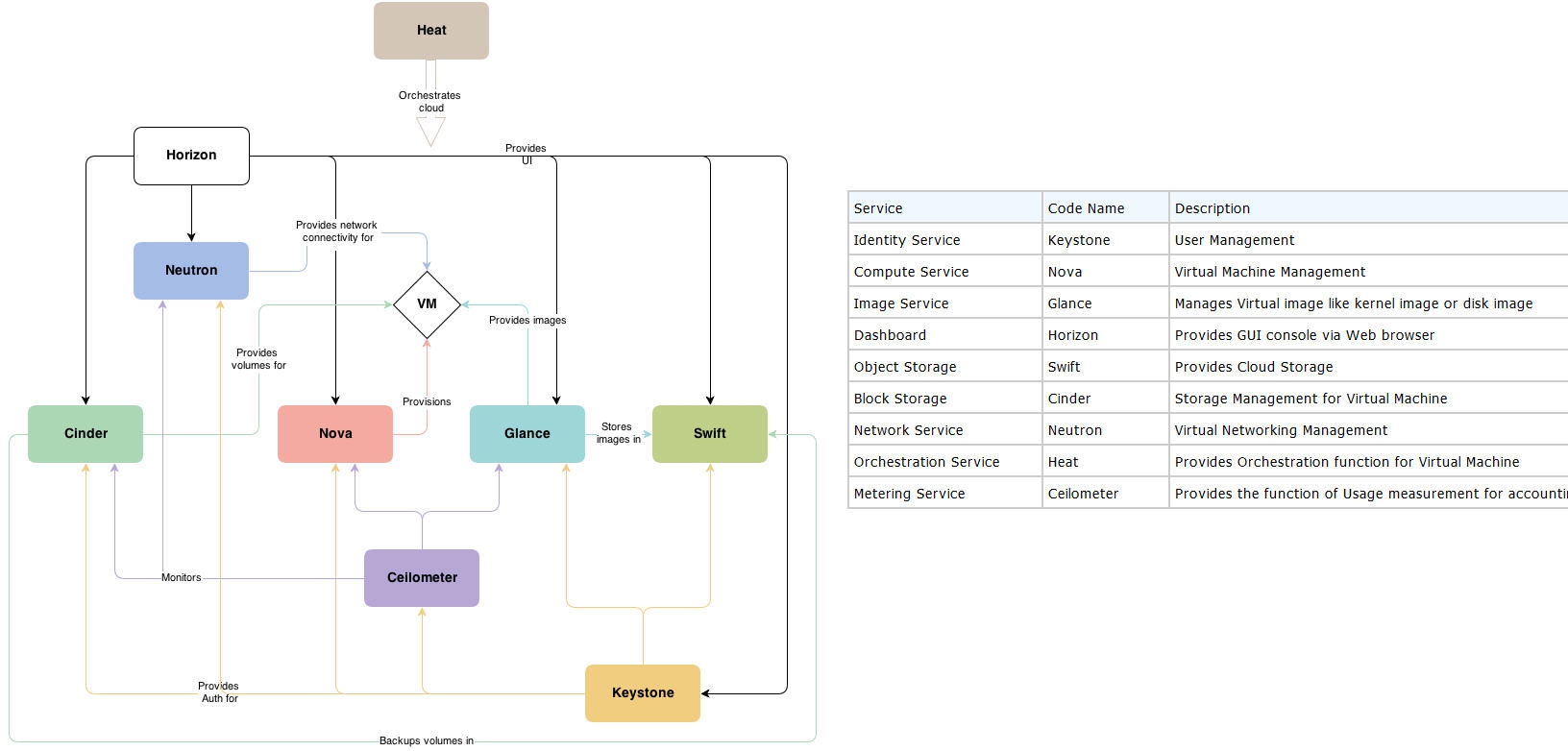OpenStack conceptual architecture
OpenStack conceptual architecture

Based on OpenStack Icehouse release
calculate instances for openstack
cpu_allocation_ratio=16.0
ram_allocation_ratio=1.5
nova flavor-list
number of instances = ( cpu_allocation_ratio x total physical cores ) / virtual cores per instance
number of instances = ( ram_allocation_ratio x total physical memory ) / flavor memory size
size of instances = number of instances x flavor disk size ( /var/lib/nova/instances )
Load environment variables
unset OS_SERVICE_TOKEN OS_SERVICE_ENDPOINT
vi ~/adminrc
export OS_USERNAME=admin
export OS_PASSWORD=ADMIN-USER-PASSWORD
export OS_TENANT_NAME=admin
export OS_AUTH_URL=http://controller:35357/v2.0
chmod 600 ~/adminrc ; source ~/adminrc
echo "source ~/adminrc " >> ~/.bash_profile
Get user-role-list script
vi get-user-role-list.py
#!/usr/bin/python
import os, prettytable, sys
from keystoneclient.v2_0 import client
from keystoneclient import utils
keystone = client.Client(username=os.environ['OS_USERNAME'], password=os.environ['OS_PASSWORD'],
tenant_name=os.environ['OS_TENANT_NAME'], auth_url=os.environ['OS_AUTH_URL'])
f_user = f_tenant = ""
if "-u" in sys.argv: f_user = sys.argv[sys.argv.index("-u")+1]
if "-t" in sys.argv: f_tenant = sys.argv[sys.argv.index("-t")+1]
tenants = [t for t in keystone.tenants.list() if f_tenant in t.name]
users = [u for u in keystone.users.list() if f_user in u.name]
pt = prettytable.PrettyTable(["name"]+[t.name for t in tenants])
for user in users:
row = [user.name]
for tenant in tenants:
row.append("\n".join([u.name for u in user.list_roles(tenant.id)]))
pt.add_row(row)
print pt.get_string(sortby="name")
chmod +x get-user-role-list.py
Notes:
Install OpenStack Clients
yum -y install python-ceilometerclient python-cinderclient python-glanceclient python-heatclient python-keystoneclient python-neutronclient python-novaclient python-swiftclient python-troveclient
Using standalone mysql server:
Hosted MySQL Server
yum -y install mysql mysql-server MySQL-python
all other openstack nodes
yum -y install mysql MySQL-python openstack-utils
1. The public_url parameteris the URL that end users would connect on. In a public
cloud environment, this would be a public URL that resolves to a public IP address.
2. The admin_url parameteris a restricted address for conducting administration.
In a public deployment, you would keep this separate from the public_URL by
presenting the service you are configuring on a different, restricted URL. Some
services have a different URI for the admin service, so this is configured using this
attribute.
3. The internal_url parameterwould be the IP or URL that existed only within the
private local area network. The reason for this is that you are able to connect to
services from your cloud environment internally without connecting over a public IP
address space, which could incur data charges for traversing the Internet. It is also
potentially more secure and less complex to do so.
KVM
yum -y install qemu-kvm libvirt python-virtinst bridge-utils
yum -y install httpd
ln -s /media /var/www/html/centos6
service httpd start
for using virt-manager
qemu-img create -f qcow2 /var/lib/libvirt/images/centos6.img 10G
virt-install -n centos6 -r 1024 --disk path=/var/lib/libvirt/images/centos6.img,format=qcow2 --vcpus=1 --os-type linux --os-variant=rhel6 --graphics none --location=http://192.168.1.12/centos6 --extra-args='console=tty0 console=ttyS0,115200n8 serial'
sohu epel:
[epel]
name=epel
baseurl=http://mirrors.sohu.com/fedora-epel/6Server/x86_64/
enabled=1
gpgcheck=0
my notes:
vi /root/checkiso.sh
#!/bin/bash
DIR=/icehouse
if [ "$(ls -A $DIR 2> /dev/null)" == '' ]; then
mount -o loop /tmp/OpenStackIcehouse.iso /icehouse/
fi
chmod +x /root/checkiso.sh
echo "/root/checkiso.sh" >> root/.bash_profile
nova live migration libvirt related configuration:
for CentOS 6.5
vi /etc/libvirt/libvirtd.conf
listen_tls = 0
listen_tcp = 1
auth_tcp = “none”
vi /etc/sysconfig/libvirtd
LIBVIRTD_ARGS="--listen"
service libvirtd restart
for Ubuntu 14.04
vi /etc/libvirt/libvirtd.conf
listen_tls = 0
listen_tcp = 1
auth_tcp = “none”
vi /etc/init/libvirt-bin.conf
改前 : exec /usr/sbin/libvirtd $libvirtd_opts
改后 : exec /usr/sbin/libvirtd -d -l
vi /etc/default/libvirt-bin
改前 :libvirtd_opts=” -d”
改后 :libvirtd_opts=” -d -l”
service libvirt-bin restart
my notes:
controller node:
[ml2]
type_drivers=vlan
tenant_network_types=vlan
mechanism_drivers=openvswitch
[ml2_type_vlan]
network_vlan_ranges = physnet1:1:4094
network node:
[ml2]
type_drivers=vlan
tenant_network_types=vlan
mechanism_drivers=openvswitch
[ml2_type_vlan]
network_vlan_ranges = physnet1:1:4094
[ovs]
bridge_mappings = physnet1:br-eth1
vi /etc/sysconfig/network-scripts/ifcfg-eth1
DEVICE=eth1
TYPE=Ethernet
ONBOOT=yes
BOOTPROTO=none
ovs-vsctl add-br br-eth1
ovs-vsctl add-port br-eth1 eth1
computer node:
[ml2]
type_drivers=vlan
tenant_network_types=vlan
mechanism_drivers=openvswitch
[ml2_type_vlan]
network_vlan_ranges = physnet1:1:4094
[ovs]
bridge_mappings = physnet1:br-eth1
vi /etc/sysconfig/network-scripts/ifcfg-eth1
DEVICE=eth1
TYPE=Ethernet
ONBOOT=yes
BOOTPROTO=none
ovs-vsctl add-br br-eth1
ovs-vsctl add-port br-eth1 eth1